Drohobych
Drohobych (Ukrainian: Дрого́бич; Russian: Дрогобыч; Polish: Drohobycz; Yiddish: דראָהאָביטש;) is a city of regional significance in Lviv Oblast, Ukraine. It is the administrative center of Drohobych district. In 1939–1941 and 1944–1959 it was the center of Drohobych Oblast.
Drohobych Дрогобич | |
|---|---|
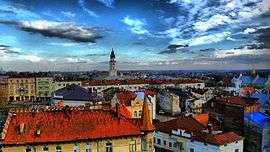 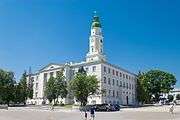  .jpg) 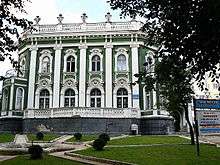 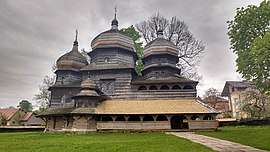 | |
 Flag  Coat of arms | |
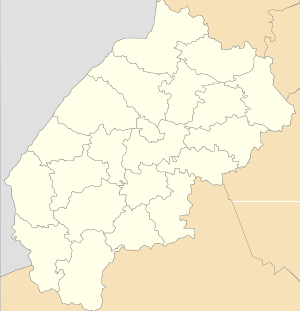 Drohobych Location of Drohobych  Drohobych Drohobych (Ukraine) | |
| Coordinates: 49°21′00″N 23°30′00″E | |
| Country | |
| Oblast | |
| Raion | Drohobych Municipality |
| First mentioned | 1387 |
| Government | |
| • Mayor | Taras Kuchma |
| Area | |
| • Total | 41.0 km2 (15.8 sq mi) |
| Population (2016) | |
| • Total | 76 686 |
| Website | http://www.drohobych-rada.gov.ua/ |
The city was founded at the end of eleventh century as an important trading post and transport node between Kyiv Rus' and the lands to the West of Rus'. After extinction of the local Ruthenian dynasty and subsequent incorporation of the Kingdom of Galicia–Volhynia into the Polish Kingdom by 1349, from the fifteenth century the city was developing as a mercantile and saltworks centre. Drohobych became part of the Habsburg Empire in 1772 after the first partition of Polish-Lithuanian Commonwealth. In the mid-nineteenth century it became Europe's largest oil extraction center, which significantly contributed to its rapid development. In the renascent, interwar Poland it was the center of a county within the Lwów Voivodeship. In the outcome of World War II the city was incorporated into the Ukrainian part of the Soviet Union, which in 1991 became the independent Ukraine.
The city was the birthplace of such well-known personalities like Elisabeth Bergner, Yuriy Drohobych (Kotermak), Ivan Franko and Bruno Schulz. The city has several oil refineries. The Drohobych saltworks are considered to be the oldest in Europe. The estimated population of the city in 2016 was 76,686.
Administrative status
As the administrative center of Drohobych Raion (district), Drohobych itself is a city of oblast significance, subordinate directly to the oblast authorities, rather than to the raion administration located in the city itself.
History
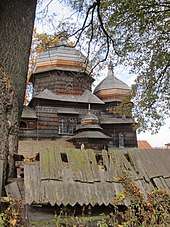
While there are only legendary accounts of it, Drohobych probably existed in the Kievan Rus' period. According to a legend, there was a settlement, called Bych, of salt-traders. When Bych was destroyed in a Cumanian raid, survivors rebuilt the settlement in a nearby location under its current name which means a Second Bych. In the time of Kievan Rus', the Tustan fortress was built near Drohobych. However, scholars perceive this legend with skepticism, pointing out that Drohobych is a Polish pronunciation of Dorogobuzh, a common East Slavic toponym applied to three different towns in Kievan Rus'.[1]
The city was first mentioned in 1387 in the municipal records of Lviv, in connection with a man named Martin (or Marcin) of Drohobych.[1] Furthermore, the same chronicler's List of all Ruthenian cities, the farther and the near ones[2] in Voskresensky Chronicle (dated 1377–82) mentions "Другабець" (Druhabets') among other cities in Volhynia that existed at the same time such as Холмъ (Kholm), Лвовъ Великій (Lviv the Great).
In 1392 Polish king Vladislav II ordered the construction of the first Roman Catholic municipal parish church (Polish: Kosciół farny), using the foundations of older Ruthenian buildings. In the Polish-Lithuanian Commonwealth, the city was the center of large rural starostvo (county within the Ruthenian Voivodeship).
Drohobych received Magdeburg rights some time in the 15th century (sources differ as to the exact year, some giving 1422 or 1460,[1] or 1496[3] but in 1506 the rights were confirmed by King Alexander the Jagiellonian). The salt industry was significant in the fourteenth to sixteenth centuries.
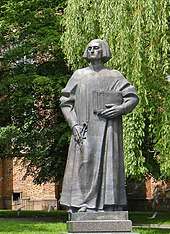
From the early seventeenth century, a Ukrainian Catholic brotherhood existed in the city. In 1648, during the Khmelnytsky Uprising, the Cossacks stormed the city and its cathedral. Most of the local Poles, as well as the Greek Catholics and the Jews, were murdered at the time, while some managed to survive in the Bell tower not taken in the raid. The 1772 partition of Poland gave the city to Austria. In the 19th century, significant oil resources were discovered in the area, making the city became an important center of the oil and natural gas industries.
After the World War I, the area became part of the short-lived independent West Ukrainian People's Republic (Zakhidnoukrayins’ka Narodna Respublika; ZUNR). The ZUNR was taken over by the Second Polish Republic in the event of Polish–Ukrainian War and Drohobych became part of the Lwów Voivodeship in 1919. In 1928 the still extant Ukrainian private gymnasium (academically oriented secondary school) opened in the center of the city. The population reached some 40,000 in the late 1920s, and its oil refinery at Polmin became one of the biggest in Europe, employing 800 people. Numerous visitors came there to view the wooden Greek Catholic churches, among them the Church of St. Yur, which was regarded the most beautiful such construction in the Second Polish Republic, with frescoes from 1691. Drohobych was also a major sports center (see: Junak Drohobycz).
In September 1939, as a result of German and Soviet invasion of Poland the city was annexed to Soviet Ukraine when the territory of the interwar Poland was divided between the Nazi Germany and the USSR according to the Ribbentrop-Molotov agreement. In Soviet Ukraine, Drohobych became the center of the Drohobych Oblast (region). It's local Polish boy scouts created the White Couriers organization, which in late 1939 and early 1940 smuggled hundreds of people from the Soviet Union to Hungary, across the Soviet-Hungarian border in the Carpathians. In early July 1941, during the first weeks of the Nazi invasion of the USSR, the city was occupied by the Nazi Germany.
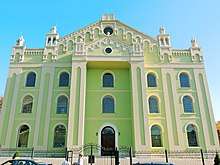
Pre-war Drohobych had a significant Jewish community of about 15,000 people, 40 % of the total population. Immediately after the Germans entered the city, Ukrainian nationalists started a pogrom, lasting for three days, supported by the German military. During 1942 there were several selections, deportations, and murders in the streets, again led out by German troops and Ukrainian auxiliary police. In October 1942, Drohobych ghetto with approximately 10,000 people imprisoned was established, also with Jews brought from neighboring localities. In June 1943, the German administration and troops liquidated the ghetto, only 800 Jews form Drohobych survived.[4][5] On 6 August 1944, the German occupation ended with the Red Army entering the city. Despite the large Jewish population prior to the war, a current resident stated that he was one of only two Jews who came back to his village to live after the war.[6] After the war, the city remained an oblast center until the Drohobych Oblast was incorporated into the Lviv Oblast in 1959. In Soviet times, Drohobych became an important industrial center of Western Ukraine with highly developed oil-refining, machine building, woodworking, food, and light industries.
Demographics
The population of Drohobych over the years was:
- 1931 – 32,300
- 1959 – 42,000
- 1978 – 65,998
- 1989 – 77,571
- 2001 – 79,119
- 2010 – 78,368
Religious and national splits:[7][3]
| Mid-18th century, Religions | 1869, Religions | 1939, Religions | 1959, Nationalities | |
| total 3,737 | total 16,880 | total 34,600 | total 42,000 | |
| 2,200 (58.8%) Jewish | 47.7% Jewish | 39.9% Jewish | 2% Jews | |
| 1,274 (34%) Roman Catholic | 23.2% Roman Catholic | 33.2% Roman Catholic | 3% Poles | |
| 263 (7%) Greek Catholic | 28.7% Greek Catholic or Orthodox | 26.3% Greek Catholic or Orthodox | 70% Ukrainians | |
| 22% Russians |
Drohobych District:
In 1931, the total population of the Drohobych district was 194,456, distributed among various languages:[8]
- Polish: 91,935 (47.3%)
- Ukrainian: 79,214 (40.7%)
- Yiddish: 20,484 (10.5%)
In January 2007, the total population of the metropolitan area was over 103,000 inhabitants.
Economy
Industries currently based in the city include oil-refineries, chemicals, machinery, metallurgy, and food processing.
Sights
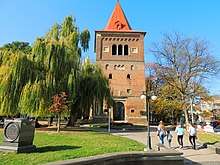
- St. George's Church, Drohobych (c. 1500)
- St. Bartholomew Church, Drohobych (1392–16th century)
- its bell tower, former castle tower (late 13th century and 15th century)
- Ascension Church, Drohobych (late 15th century)
- Holy Cross Church, Drohobych (early 16th century)
- Choral Synagogue (1842–1865)
- Progressive Synagogue, Drohobych
- City Hall, Drohobych (1920s)
- St. Peter's and Paul's Monastery, Drohobych
- Drohobych Museum
- St-George Church, 16th–17th centuries
- Church of the Holy Cross, 1613–1661
- Brick Gothic St-Bartholomew Church (14th–16th centuries) and its bell tower
 Town Hall
Town Hall- Basilian monastery of Saints Peter and Paul, 1825–1828
 A historic building in Drohobych
A historic building in Drohobych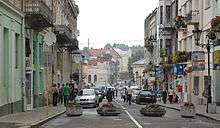 Mazepy Street in Drohobych
Mazepy Street in Drohobych.jpg) Osmomysla Street, Drohobych
Osmomysla Street, Drohobych- Villa of Raymond Jarosz
- Bianchi Palace
.jpg) Shevska Street, Drohobych
Shevska Street, Drohobych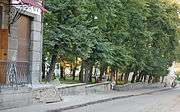 Drohobych City Park
Drohobych City Park
Notable people
Politics
- Zenon Kossak, Ukrainian military and political leader (born here)
- Andriy Melnyk, Ukrainian military and political leader (born near Drohobych)
- David Horowitz (economist), Israeli economist and the first Governor of the Bank of Israel.
Arts
- Ivan Franko, Ukrainian poet and writer, born in Nahuievychi, near Drohobych
- Irene Frisch, Jewish-Polish writer and memoirist
- Leopold Gottlieb, Jewish-Polish painter
- Maurycy Gottlieb, Jewish-Polish painter
- Ephraim Moses Lilien, Jewish-Zionist painter
- Alfred Schreyer, Jewish-Polish vocalist and violinist
- Bruno Schulz, Polish-Jewish writer, graphic artist, and literary critic
- Kazimierz Wierzyński, Polish poet and writer
David Grunschlag, violinist, founding member and concertmaster of Israel philharmonic orchestra (1936-1959) first violinist Philadelphia Orchestra (1960-1984)
Other fields
- Tadeusz Chciuk-Celt, Polish war hero
- Yuriy Drohobych, first doctor of medicine in Ukraine, 1481–1482 rector of the University of Bologna
- Yaroslav Popovych, cyclist (born here)
- Józef Schreier, Polish-Jewish mathematician
- Viktor Vekselberg, Russian oligarch
Twin towns and sister cities
Drohobych is twinned with:
| City | Country | Since |
|---|---|---|
| Bytom | ||
| Buffalo, New York | ||
| Dębica[9] | ||
| Legnica | ||
| Muscatine, Iowa | ||
| Olecko | ||
| Smiltene |
References
- Історія Дрогобича [History of Drohobych] (in Ukrainian). drohobych.net. Archived from the original on 16 January 2006.
- А СЕ ИМЕНА ГРАДОМЪ ВСЂМЪ РУССКЫМЪ, ДАЛНИМЪ И БЛИЖНИМЪ in PSRL, Т. VII. Летопись по Воскресенскому списку. — СПб, 1856. — с. 240–41.
- Kubijovyč, Volodymyr (2016). "Drohobych". Online Encyclopedia of Ukraine. Retrieved 19 December 2016.
- Israel Gutman u. a. (Hrsg.): Enzyklopädie des Holocaust. München und Zürich 1995, ISBN 3-492-22700-7, vol. 1, p. 371.
- Преступления нацистов на территории СССР [Nazis crimes in the territory of the USSR] (in Russian). holocaust.ioso.ru. Archived from the original on 2 September 2006.
- "Execution Sites of Jewish Victims Investigated by Yahad-In Unum: Execution of Jews in Drogobych". yahadmap.org. 2005. Retrieved 19 December 2016.
- Motylewicz, Jerzy (2005). "Ethnic Communities in the Towns of the Polish-Ukrainian Borderland in the Sixteenth, Seventeenth, and Eighteenth Centuries". In C. M. Hann; Paul R. Magocsi (eds.). Galicia: A Multicultured Land. University of Toronto Press. p. 37. ISBN 978-0-8020-3781-7. Retrieved 19 December 2016.
- Bielawa, Matthew (2002). "Genealogy of Halychyna/Eastern Galicia: 1931 Polish Statistics: Population by language". halgal.com. Retrieved 19 December 2016.
- "Partnerstwo Samorządów Siłą Europy" [Local Government Partnerships as the Power of Europe]. Europa Miast (in Polish). Archived from the original on 2016-08-09. Retrieved 2013-08-13.
External links
- Drohobyczer Zeitung
- Drohobych Info - biggest news site (in Ukrainian)
- Drohobych - city portal (in Ukrainian)
- Drohobych.com - Drohobych city administration website (in Ukrainian)
- Drohobych in Verkhovna Rada of Ukraine database (in Ukrainian)
- Drohobych the King's city (in Ukrainian)
- Drohobych.Net (in Ukrainian)
- Stories by Irene Frisch, a Drohobych-born Holocaust Survivor
- Drohobych in Encyclopedia of Ukraine
- Seminary of Blessed Martyrs Severyn, Yakym and Vitalij of Ukrainian Greek Catholic Church, in Drohobych
- Drohobych during the period of Nazism (PHOTOS)
- Drohobych, Ukraine at JewishGen